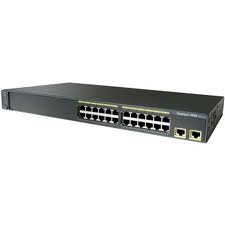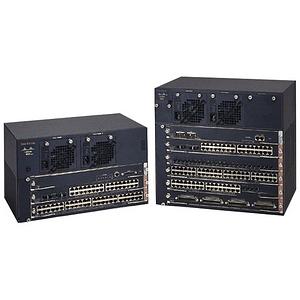IOS vs. CatOS: Basic Configuration: Difference between revisions
No edit summary |
No edit summary |
||
| (74 intermediate revisions by the same user not shown) | |||
| Line 1: | Line 1: | ||
== | {| border="0" width="100%" cellpadding="1" | ||
| | |||
=IOS= | |||
IOS (Internetwork Operating System) is the operating system primarily used for the majority of Cisco's current equipment, including Routers and Switches. | |||
IOS uses different configuration modes, depending on what your currently configuring. For example - if you wanted to turn a port on in IOS, you would first need to be in priviledged exec -> global configuration -> and move into interface configuration, then issue the ''no shutdown'' command. | |||
[[File:Cat2960.jpg|right]] | |||
| | |||
=CatOS= | |||
CatOS is the operating system used on Cisco's Catalyst switches before changing over to IOS. Before purchasing the technology from Crescendo in 1993, CatOS was called XDI. CatOS is a Unix-like operating system for many legacy Cisco switches. CatOS runs on the following switch series: 1200, 4000, 4500, 5000, 5500, 6000 and 6500. Some of the high end switches such as the Catalyst 6500 series still run CatOS. | |||
( | User mode is used for system monitoring. Priviledged (enable) mode is used to change all system configurations. All configurations in CatOS are done by a ''set'' command sequence. | ||
[[File:Cat4006.jpg|right]] | |||
|} | |||
= Commands = | |||
On this page we will be comparing two switches; a Catalyst 2960 running IOS and a Catalyst 4006 running CatOS. | |||
In IOS, the user is required to issue a command to save to NVRAM. | |||
Commands entered in CatOS are committed to NVRAM instantaneously. | Commands entered in CatOS are committed to NVRAM instantaneously. | ||
{| border="0" width="80%" | {| border="0" width="80%" | ||
|- | |- | ||
| Line 50: | Line 47: | ||
|- | |- | ||
!Turn on ports | !Turn on ports | ||
| (config- | | (config-int)no shutdown | ||
| (enable)set port enable ''mod/port'' | | (enable)set port enable ''mod/port'' | ||
|- | |- | ||
!Turn off ports | !Turn off ports | ||
| (config- | | (config-int)shutdown | ||
| (enable)set port disable ''mod/port'' | | (enable)set port disable ''mod/port'' | ||
|- | |- | ||
| Line 60: | Line 57: | ||
| (config-t)banner-motd # ''banner here'' # | | (config-t)banner-motd # ''banner here'' # | ||
| (enable)set banner motd # ''banner here'' # | | (enable)set banner motd # ''banner here'' # | ||
|- | |||
!Clear Banner | |||
| (config-t) | |||
| (enable)clear banner motd | |||
|- | |- | ||
!System / Hostname | !System / Hostname | ||
| (config)hostname ''name'' | | (config)hostname ''name'' | ||
| (enable)set system name ''name'' | | (enable)set system name ''name'' | ||
|- | |||
!Set Idle Logout time | |||
| (config-t) | |||
| (enable)set logout ''time'' (in minutes) | |||
|- | |- | ||
!Bandwidth | !Bandwidth | ||
| (config- | | (config-int)bandwidth ''number in kb'' | ||
| (enable)set port speed ''speed in megabits'' | | (enable)set port speed ''speed in megabits'' | ||
|- | |- | ||
| Line 74: | Line 79: | ||
|- | |- | ||
!Enabling VLANS | !Enabling VLANS | ||
| (config-t) vlan ''number'' (will put switch into sub-config mode, but the vlan will become active) | | (config-t)vlan ''number'' (will put switch into sub-config mode, but the vlan will become active) | ||
| (enable)set vlan ''number'' state ''active'' | | (enable)set vlan ''number'' state ''active'' | ||
|- | |- | ||
| Line 80: | Line 85: | ||
| (config-vlan)name ''name'' | | (config-vlan)name ''name'' | ||
| (enable)set vlan ''vlan number'' name ''name'' | | (enable)set vlan ''vlan number'' name ''name'' | ||
|- | |||
!Delete VLANS | |||
| (config-t)no vlan ''number'' | |||
| (enable)clear vlan ''number'' | |||
|- | |||
!Enabling Trunking | |||
| (config-int)switchport mode trunk | |||
| (enable)set trunk ''mod_num/port_num [on/off/desirable/auto/nonegotiate] [vlan_range] [isl/dot1q/dot10/lane/negotiate] | |||
|- | |||
!Clear Trunking | |||
| (config-int)no switchport mode trunk | |||
| (enable)clear trunk ''mod/port'' ''vlan range'' | |||
|- | |||
!Delete files from Flash Device | |||
| (enable)delete flash:''filename'' | |||
| (enable)delete bootflash:''filename'' | |||
|- | |||
!Spanning-Tree | |||
| (config-t)spanning-tree ''vlan'' | |||
| (enable)set spantree enable all | |||
|- | |- | ||
|} | |} | ||
= Troubleshooting = | |||
{|border="0" style="width:400px" | {|border="0" style="width:400px" | ||
| Line 91: | Line 116: | ||
|- | |- | ||
! | ! | ||
| | |ping | ||
| | |ping | ||
|- | |- | ||
! | ! | ||
|tracert | |tracert | ||
| | |traceroute | ||
|- | |- | ||
! | ! | ||
|show run | |show run | ||
| | |show running-config all | ||
|- | |- | ||
! | ! | ||
|copy run start | |copy run start | ||
| | |copy config | ||
|- | |- | ||
! | ! | ||
|erase start | |erase start | ||
| | |clear config all | ||
|- | |- | ||
|} | |} | ||
__NOTOC__ | |||
Latest revision as of 20:46, 3 May 2011
IOSIOS (Internetwork Operating System) is the operating system primarily used for the majority of Cisco's current equipment, including Routers and Switches. IOS uses different configuration modes, depending on what your currently configuring. For example - if you wanted to turn a port on in IOS, you would first need to be in priviledged exec -> global configuration -> and move into interface configuration, then issue the no shutdown command. |
CatOSCatOS is the operating system used on Cisco's Catalyst switches before changing over to IOS. Before purchasing the technology from Crescendo in 1993, CatOS was called XDI. CatOS is a Unix-like operating system for many legacy Cisco switches. CatOS runs on the following switch series: 1200, 4000, 4500, 5000, 5500, 6000 and 6500. Some of the high end switches such as the Catalyst 6500 series still run CatOS. User mode is used for system monitoring. Priviledged (enable) mode is used to change all system configurations. All configurations in CatOS are done by a set command sequence. |
Commands
On this page we will be comparing two switches; a Catalyst 2960 running IOS and a Catalyst 4006 running CatOS.
In IOS, the user is required to issue a command to save to NVRAM.
Commands entered in CatOS are committed to NVRAM instantaneously.
| IOS Command | CatOS Command | |
|---|---|---|
| Privileged | Enable | Enable |
| Interface | (config-t)interface int (which puts you into interface configuration mode) | (enable)set port command mod/port |
| Set Console Password | (config-line)password password | (enable)set password (you will be prompted to change password) |
| Turn on ports | (config-int)no shutdown | (enable)set port enable mod/port |
| Turn off ports | (config-int)shutdown | (enable)set port disable mod/port |
| Banner-MOTD | (config-t)banner-motd # banner here # | (enable)set banner motd # banner here # |
| Clear Banner | (config-t) | (enable)clear banner motd |
| System / Hostname | (config)hostname name | (enable)set system name name |
| Set Idle Logout time | (config-t) | (enable)set logout time (in minutes) |
| Bandwidth | (config-int)bandwidth number in kb | (enable)set port speed speed in megabits |
| Setting up a domain name for VTP | (config-t)vtp domain domain-name | (enable)set vtp domain domain-name |
| Enabling VLANS | (config-t)vlan number (will put switch into sub-config mode, but the vlan will become active) | (enable)set vlan number state active |
| VLAN names | (config-vlan)name name | (enable)set vlan vlan number name name |
| Delete VLANS | (config-t)no vlan number | (enable)clear vlan number |
| Enabling Trunking | (config-int)switchport mode trunk | (enable)set trunk mod_num/port_num [on/off/desirable/auto/nonegotiate] [vlan_range] [isl/dot1q/dot10/lane/negotiate] |
| Clear Trunking | (config-int)no switchport mode trunk | (enable)clear trunk mod/port vlan range |
| Delete files from Flash Device | (enable)delete flash:filename | (enable)delete bootflash:filename |
| Spanning-Tree | (config-t)spanning-tree vlan | (enable)set spantree enable all |
Troubleshooting
| IOS Command | CatOS Command | |
|---|---|---|
| ping | ping | |
| tracert | traceroute | |
| show run | show running-config all | |
| copy run start | copy config | |
| erase start | clear config all |

